The Great Grey Owl (Strix nebulosa) emerges as a majestic sentinel in the northern realms, captivating enthusiasts and naturalists alike.
Renowned for its unparalleled size and distinctive features, this awe-inspiring owl stands as the largest member of its species worldwide.
With a wingspan reaching up to 5 feet (1.5 meters), the Great Grey Owl dominates the boreal and taiga landscapes of North America, Europe, and Asia.
Its cryptic plumage, marked by a prominent facial disk and piercing yellow eyes, conceals its presence amidst coniferous woodlands.
A master of silent flight, this nocturnal hunter relies on acute hearing and specialized feathers to navigate the darkness with unparalleled precision.
From its enigmatic nesting behaviors to its crucial role in controlling rodent populations, the Great Grey Owl unfolds a captivating tale of survival and adaptation in the pristine wilderness it calls home.
As a symbol of the northern wilderness, the Great Grey Owl stands as an ambassador of the intricate ecosystems it inhabits. Stay focused.
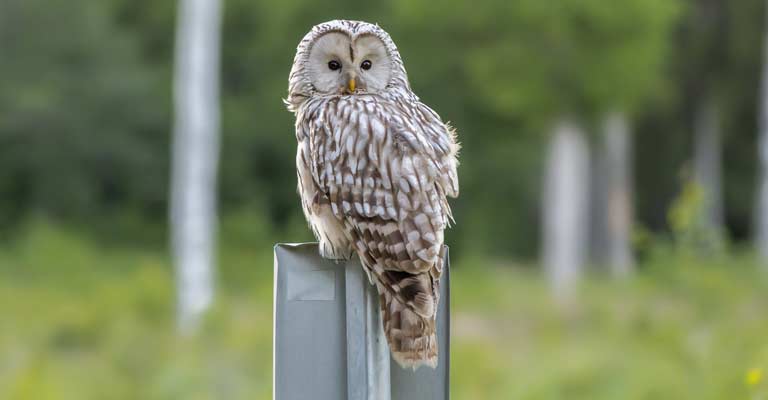
Physical Characteristics of the Great Grey Owl
The Great Grey Owl (Strix nebulosa) is an impressive and distinctive bird of prey known for its large size, striking appearance, and unique physical characteristics.
Identifying this specific owl requires attention to various details that set it apart from other owl species. Here are some of the key points to help you identify the Great Grey Owl:
Size and Proportions
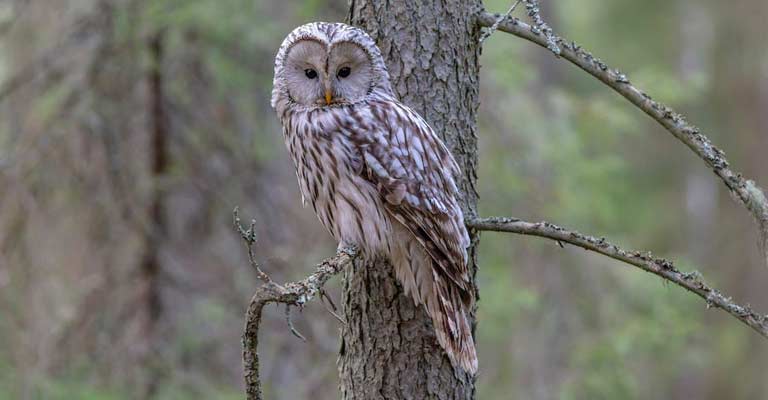
The Great Grey Owl is one of the largest owl species in the world, boasting an impressive wingspan that can reach up to 5 feet (1.5 meters).
Despite its size, it has a relatively slim and elongated body, giving it a distinctive appearance compared to other large owls.
Facial Disk
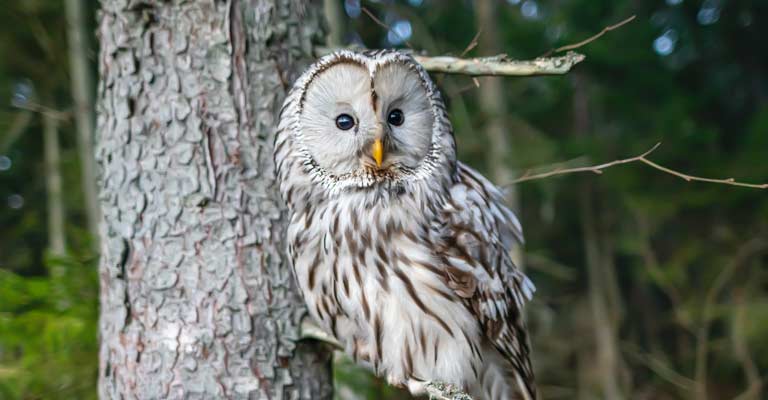
One of the defining features of the Great Grey Owl is its large facial disk.
The disk is a circular arrangement of feathers around the owl’s face that helps in directing sound towards its ears, aiding in efficient hunting.
The facial disk is usually light grey or white, enhancing its overall striking appearance.
Coloration
The plumage of the Great Grey Owl is predominantly grey, with a variety of shades ranging from light to dark.
The owl’s intricate feather patterns provide excellent camouflage in its natural habitat of boreal forests.
The underparts are often lighter in color than the upperparts, creating a beautiful contrast.
Yellow Eyes
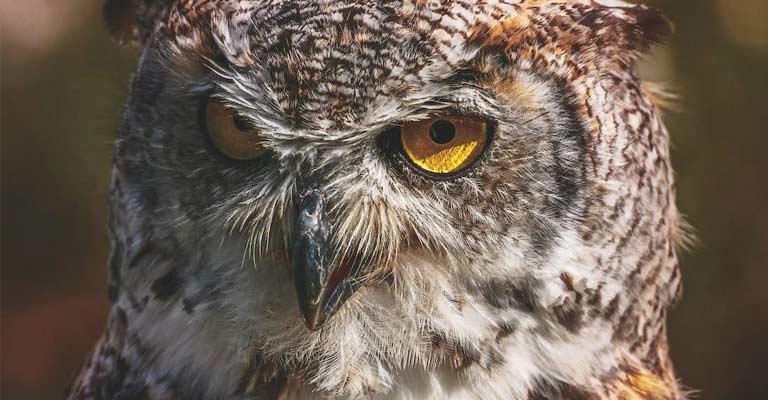
The piercing yellow eyes of the Great Grey Owl are another distinctive feature. These bright, intense eyes stand out against the owl’s grey facial disk and contribute to its captivating and intimidating presence.
Ear Tufts
Unlike some other owl species, the Great Grey Owl possesses prominent ear tufts, which are feathered projections on the top of its head resembling “horns.”
Despite their name, these tufts have nothing to do with the owl’s hearing but serve a role in communication and camouflage.
Lack of Ear Faculties
Despite the ear-like projections, the actual ear openings of the Great Grey Owl are not easily visible.
This lack of apparent ear faculties distinguishes it from other owl species where ear openings are often more conspicuous.
Adaptations for Silent Flight
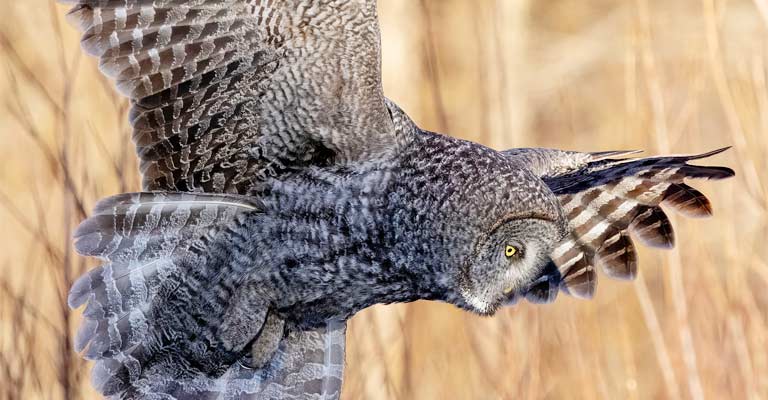
Similar to other owls, the Great Grey Owl has specialized feathers with fringed edges that help reduce noise during flight, allowing it to approach prey silently.
This adaptation is crucial for its success as a nocturnal hunter.
Habitat and Range
The Great Grey Owl is primarily found in the northern hemisphere, inhabiting dense boreal forests and coniferous woodlands.
Its preference for these habitats, combined with its unique physical characteristics, aids in distinguishing it from other owl species in various ecosystems.
The Great Grey Owl’s impressive size, facial disk, coloration, eye color, ear tufts, and habitat preferences collectively make it a distinctive and easily identifiable bird of prey in the avian world.
Observing these key features will enable bird enthusiasts and nature lovers to recognize and appreciate the majesty of the Great Grey Owl in its natural environment.
Taxonomical Details of Great Grey Owl
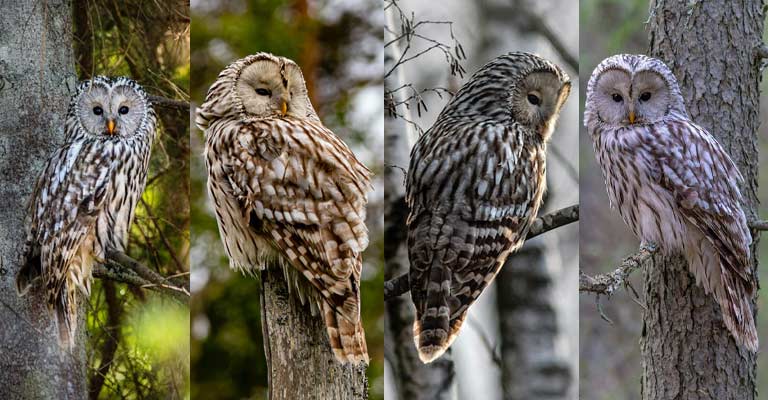
The given table summarizes the taxonomy details of the Great Grey Owl:
| Taxonomic Rank | Classification |
| Domain | Eukaryota |
| Kingdom | Animalia |
| Phylum | Chordata |
| Class | Aves |
| Order | Strigiformes |
| Family | Strigidae |
| Genus | Strix |
| Species | S. nebulosa |
The Great Grey Owl (Strix nebulosa) exhibits remarkable adaptability across its vast range, with two recognized subspecies enriching the avian diversity of North America and Eurasia.
- S. n. nebulosa (Forster, 1772), North American Subspecies: Found in the expansive landscapes of North America, this subspecies thrives from central Alaska across Canada to south-western Quebec. Its range extends southward to encompass northern California, northern Idaho, western Montana, Wyoming, and north-eastern Minnesota. The North American Great Grey Owl showcases a resilience that enables it to navigate diverse habitats, from the boreal forests of Alaska to the coniferous woodlands of the western United States.
- S. n. lapponica (Thunberg, 1798), Eurasian Subspecies: In Eurasia, the Great Grey Owl takes on the distinct characteristics of the lapponica subspecies. Its habitat spans from Fennoscandia through Siberia to Sakhalin and Kamchatka Krai. The range further encompasses territories such as Lithuania, Lake Baikal, Kazakhstan, Mongolia, Manchuria, and north-eastern China. Across this vast expanse, the Eurasian Great Grey Owl adapts to the varied landscapes, demonstrating its ability to thrive in taiga regions and diverse forest ecosystems.
These two subspecies contribute to the intricate tapestry of Great Grey Owl diversity, showcasing how this magnificent species has adapted to different environments and climates on both sides of the globe.
Habitation and Range Map of the Great Grey Owl
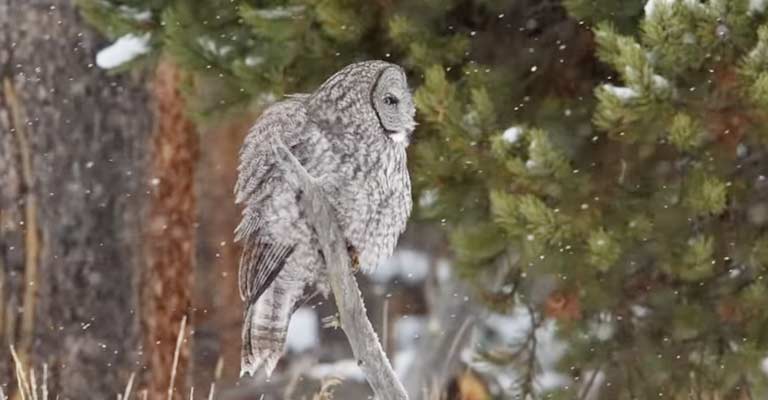
The Great Grey Owl (Strix nebulosa) is a bird of the northern hemisphere, known for its vast habitat range across North America, Europe, and Asia.
Its habitation and range map reflects its preference for boreal forests and coniferous woodlands, with specific adaptations to thrive in these environments.
Range Map
In North America, the Great Grey Owl is found throughout Canada, from the western provinces to the eastern territories, extending into Alaska.
It inhabits dense coniferous forests, particularly those dominated by spruce, fir, and pine trees.
The bird’s range extends southward into parts of the United States, including the northern states of the Rocky Mountains and the upper Midwest.
In Europe, the Great Grey Owl is distributed across Scandinavia and Russia, where it occupies the extensive boreal forests and taiga regions.
The owl’s range in Asia covers Siberia and parts of northern China, Mongolia, and Japan.
The preference for remote and sparsely populated areas characterizes its habitat, reflecting its elusive and solitary nature.
Habitat Characteristics
Great Grey Owls are adapted to life in these cold and often harsh environments.
They are particularly fond of areas with open clearings within the forests, providing suitable hunting grounds where they can spot prey easily.
These clearings also offer the opportunity for their characteristic silent flight, a crucial skill for efficient nocturnal hunting.
The vast range of the Great Grey Owl is often associated with the availability of its primary prey, small mammals like voles and mice, which are abundant in these boreal ecosystems.
Additionally, the bird’s cryptic plumage helps it blend seamlessly with the tree bark, providing effective camouflage against potential predators and ensuring successful hunting endeavors.
Understanding the habitation and range map of the Great Grey Owl underscores its adaptability to diverse ecosystems within the boreal and taiga regions, highlighting the significance of these pristine habitats for the conservation of this magnificent species.
Conservation efforts focused on preserving these extensive and remote woodlands are crucial for maintaining the populations of the Great Grey Owl across its vast range.
Great Grey Owl Life History
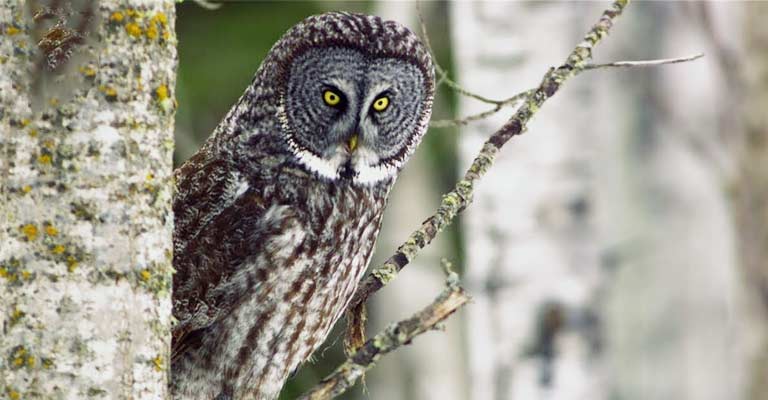
The Great Grey Owl (Strix nebulosa), with its imposing presence and unique features, has a captivating life history that unfolds in the boreal and taiga regions of North America, Europe, and Asia.
This majestic owl, renowned for its size and silent flight, exhibits distinctive behaviors in various aspects of its life.
From feeding habits and nesting behaviors to breeding strategies and conservation concerns, the Great Grey Owl’s life history is a testament to its adaptation to the remote and often harsh environments it calls home.
Food
Great Grey Owls are primarily nocturnal hunters with a diverse diet that centers around small mammals.
Their preferred prey include voles, mice, and other rodents, showcasing their ecological role in controlling these populations.
Exceptional hunters, use their acute hearing and silent flight to locate and capture prey in the dark.
Their large size and powerful talons enable them to tackle prey larger than themselves, contributing to their success as top predators in their ecosystems.
Nesting
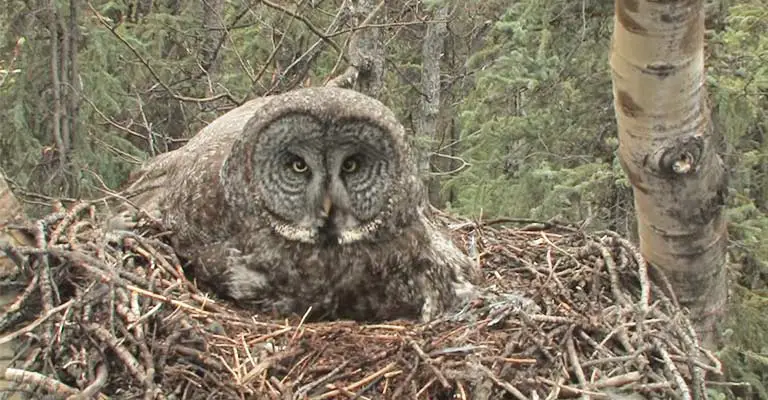
Nesting is a crucial aspect of the Great Grey Owl’s life history. They often utilize abandoned nests of other large birds, such as hawks or ravens, or even tree cavities.
The female is responsible for incubating the eggs while the male provides food.
The choice of nesting sites is strategic, typically located in dense coniferous forests to provide shelter and protection for their offspring.
Here’s a comprehensive table detailing the nesting details of the Great Grey Owl:
| Nesting Details | Facts |
| Clutch Size | 2 to 5 eggs |
| Number of Broods | Typically one brood per year |
| Egg Length | Approximately 2.1 to 2.4 inches (5.3 to 6.1 cm) |
| Egg Width | Approximately 1.7 to 1.9 inches (4.3 to 4.8 cm) |
| Incubation Period | About 28 to 36 days |
| Nestling Period | Approximately 28 to 36 days |
| Egg Description | Round or slightly elliptical; white or creamy with minimal markings, often unmarked but can have faint spots or blotches |
These nesting details provide insights into the reproductive behavior of the Great Grey Owl, highlighting aspects such as clutch size, brood frequency, egg dimensions, and the duration of incubation and nestling periods.
These factors collectively contribute to the species’ reproductive success and population dynamics in their native habitats.
Breeding
Breeding season for Great Grey Owls usually occurs in the late winter or early spring. These owls are known for their relatively low reproductive rate, with females laying a small clutch of eggs.
The chicks, once hatched, are dependent on their parents for an extended period before becoming independent. This slow reproductive pace makes conservation efforts crucial for maintaining their populations.
Diseases
While the Great Grey Owl faces various threats, diseases can also impact their well-being. Avian diseases, such as West Nile Virus and aspergillosis, can pose serious risks to owl populations.
Monitoring and understanding the prevalence of these diseases is vital for developing effective conservation strategies.
Treatment
In cases of disease outbreaks or injuries, rehabilitation, and veterinary care become essential. Avian experts and wildlife rehabilitators play a crucial role in treating injured or sick Great Grey Owls.
Timely intervention, proper diagnosis, and rehabilitation efforts contribute to the overall health and survival of individual birds and, consequently, the conservation of the species.
Conservation
The conservation of Great Grey Owls involves addressing habitat loss, ensuring sustainable forestry practices, and minimizing human disturbances in their habitats.
Conservation efforts also include monitoring and research to understand population dynamics, migration patterns, and the impact of climate change on these majestic birds.
Community involvement, education, and awareness campaigns are integral components of successful conservation initiatives, promoting a harmonious coexistence between humans and the Great Grey Owl in their shared ecosystems.
The life history of the Great Grey Owl is a compelling narrative that intertwines with the delicate balance of its ecosystems.
By delving into their feeding habits, nesting behaviors, breeding strategies, disease management, and conservation challenges, we gain a deeper appreciation for the intricate web of life that sustains this magnificent species in the wild.
5 Fun Facts About Great Grey Owl
The Great Grey Owl (Strix nebulosa), an enigmatic inhabitant of boreal forests, captures the imagination with its impressive size and distinctive features.
Beyond its striking appearance, this magnificent bird harbors a trove of intriguing facts that add to its allure.
- Largest Owl Species: The Great Grey Owl holds the title of the world’s largest owl, with a wingspan that can reach up to 5 feet (1.5 meters), showcasing its commanding presence in the avian realm.
- Facial Disk Mimicry: Sporting a facial disk that aids in sound localization, this owl exhibits a unique behavior, when threatened, it elongates its body, resembling a tree branch to escape detection from potential predators.
- Silent Flight Expert: Renowned for its silent flight, the Great Grey Owl’s specialized feathers minimize sound, allowing it to approach prey stealthily in the dark, a skill essential for its nocturnal hunting lifestyle.
- Ear Tuft Communication: Despite their name, the owl’s ear tufts have no relation to hearing but are believed to play a role in communication and expression, adding an intriguing aspect to their behavior.
- Inhabitant of the North: Thriving in the northern hemisphere, this owl’s range spans across North America, Europe, and Asia, showcasing its adaptability to the diverse ecosystems of boreal and taiga regions.
Wrapping Up
In the realm of avian wonders, the Great Grey Owl stands as a majestic sentinel of boreal forests.
Its impressive size, silent flight, unique nesting habits, and captivating features paint a vivid portrait of a species intricately woven into the ecosystems it inhabits.
From the mysteries of its nocturnal hunting to the delicate intricacies of its reproductive journey, the Great Grey Owl’s life history unfolds with grace and resilience.
Appreciating the nuances of this magnificent bird enriches our connection with the natural world, emphasizing the importance of conservation efforts to safeguard its habitats and ensure the continuation of its awe-inspiring existence. Thank you so much.